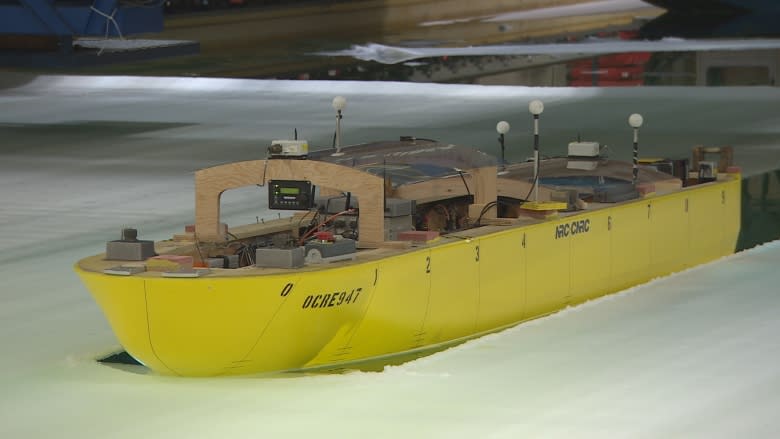U.S. Coast Guard testing new icebreaker designs at St. John's research facility
The United States is using a Newfoundland research facility to help design icebreakers that its coast guard will use for decades to come.
The U.S. Coast Guard plans to have their new heavy polar icebreakers in the water by 2023.
Before that happens, extensive testing is required to make sure the new ships can hold for 40 or 50 years of hard work patrolling the oceans between the north and south poles.
Since February, much of that testing has been taking place at the National Research Council (NRC) facility in St. John's, where model boats have been going through simulations in an ice tank to work out the best design for the new icebreakers.
"There's not a lot of tanks in the world that can generate ice where you can actually do testing of hull forms and propulsion systems, a lot of those are in Europe," said Rear Admiral Mike Haycock with the U.S. Coast Guard.
"So we're blessed to have one right across the border up in Canada."
Versatile ships
The testing involves using various models of different vessels in the ice tank to determine what designs are best for different tasks. The goal is to come up with a single design that can do all of the unique tasks required by the U.S. Coast Guard.
The tests also allow the coast guard to figure out what engine is required to push the ship, as well as the amount of fuel needed, and much more.
"Essentially what they're looking at is a number of different designs," said NRC Director Jim Millan.
"So the one we saw today worked good, but maybe there's a better one. A ship that's good at turning in the ice may not necessarily be best at transitioning straight through and breaking ice straight."
Unique demands
There are a lot of different factors that the Americans look for in their icebreakers, compared to countries that actually border the arctic and antarctic regions.
According to Haycock, that means finding a way to design a vessel that can crush through heavy ice in the earth's coldest regions while being able to sail through the open oceans in areas much warmer, such as the equator.
"One of the things that makes our U.S. icebreaker design challenging is we have to not only break ice, but we have to get to the ice," he said.
"An icebreaker that might work in Finland or Sweden or confined to operations in the northern part of Canada might not work for the U.S. Coast Guard, because we have to make those long transits to get where we're going."
The current U.S. icebreakers were built in the 1970s and are getting close to being retired. Since the new vessels could be in operation for just as long, it's important to do testing — like that being done in St. John's — to make sure everything is done right.
The U.S. decided to use the NRC facility in St. John's after observing the testing done by Canada three years ago, when it was designing its own fleet.
While the current testing is solely for the design of the American ships, the countries have a symbiotic relationship when it comes to sharing the data and Canada can use any of the test results done by the U.S. for its own purposes.





